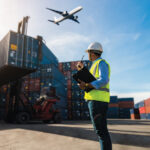South Africa’s ports: a significant barrier to trade
South Africa’s ports: a significant barrier to trade
The numbers are in and they do not look pretty. South Africa’s ports plumb the depths of the World Bank and S&P Global Market Intelligence’s 2022 Container Port Performance Index (CPPI), reveals CHRIS HATTINGH.
Of the 348 total international ports and facilities ranked on the Index, the Port of Gqeberha (formerly Port Elizabeth) ranked 291st, Durban 341st, and Cape Town 344th.
South Africa’s neighbours performed better, with Mozambique’s Beira ranked 223rd and Maputo 248th. Namibia’s Walvis Bay managed 293rd position.
The top two ports on the CPPI, which is “based on available empirical objective data pertaining exclusively to time expended in a vessel stay in a port”, are China’s Yangshan Port followed by the Port of Salalah in Oman.
South Africa’s poorly performing ports, along with the decline in reliability and availability of rail freight, resulted in lost exports amounting to roughly R150 billion over the course of 2022, according to the Minerals Council of South Africa. This estimate was based on comparing annual shipments with the design capacity of rail lines to ports. While crippling for the mining and agriculture industries specifically, low-performing ports and rail also impact negatively on the wider economy. Additionally, moving fewer commodities exports than before affects the tax revenue government can collect, creating more pressure points in other spending priorities and adding pressure in – as the most prescient examples – public sector wage negotiations and social welfare programmes.
Globally, the importance of maritime trade cannot be underestimated. The available data underline why it is vital that countries aspiring to higher levels of growth, job creation, and an improvement in quality get basic trade infrastructure right.
According to the CPPI Executive Summary, “More than 80% of global merchandise trade (by volume) is transported via sea routes. A considerable and increasing proportion of this volume, accounting for about 35% of total volumes and over 60% of commercial value, is carried in containers.”
Containers are especially critical, as is facilitating their easier flow: “Container ports are critical nodes in global supply chains and essential to the growth strategies of many emerging economies,” notes the summary. “In numerous cases, the development of high-quality container port infrastructure operating efficiently has been a prerequisite for successful export-led growth strategies. Countries that follow such a strategy will have higher levels of economic growth than those that do not.”
Over the last two years there has been talk about, and a measure of overture towards, opening up the Transnet monopoly in ports and rail to private sector investment. But at the time of writing even the ostensibly “spun off” entity that is the Transnet National Ports Authority has yet to be provided with a board. Transnet itself is by all accounts running with a far-depleted board, and as of late is struggling with cable theft on its lines. For the week that ended 21 May, the corridor that runs from the Port of Durban to Johannesburg’s City Deep station operated at only 25% capacity, while the previous week it ran at 36% capacity.
Along with adequately tackling basic theft issues, there are numerous opportunities for increased private sector investment and involvement throughout the railways, as well as at the ports. This will only come about, however, by removing the caveat that Transnet must remain the custodian of infrastructure, including new investments. This barrier is likely to act as too great a disincentive for real, robust private sector buy-in, as it fundamentally undermines any serious attempt at a return on investment.
Increased digitisation, speed of unloading and moving through containers and contents, and the ability to track one’s goods are all basic operational matters that ports ranked higher on the CPPI manage to get right, year after year. The latest talk is that Transnet aims to establish an “infrastructure manager” to allow private companies to run trains on key freight tracks by the end of October. Time will tell whether this proves to be legitimate and, even more importantly, whether such an entity will be allowed to operate free from the constraints of cadre deployment and other political considerations and pressures.
Inefficient ports act as a form of Non-Tariff Trade Barrier. Laborious processes and unnecessary delays increase the costs for importers and exporters and other businesses across industries and value chains. With consumer price inflation at 6.8% in April, down slightly from 7.1% in March but still more stubborn than many had hoped, all avenues of lowering businesses’ costs and burdens should be pursued without delay. South African businesses and consumers would benefit immeasurably from a more capable and trade-friendly trade infrastructure space.
In the 2021 edition of the CPPI, which ranked 370 facilities, Cape Town was 365th and Durban 364th, with Gqeberha highest at 312th. That the country’s ports continue to perform so poorly a year later, without shifting much in terms of improving efficiency, indicates that – despite the talk of reform – not much of substance is yet being seen.
Published by
Chris Hattingh
focusmagsa




